Infrastructure in Arkansas Earns D+
October 17th, 2014 | By: Infrastructure Report Card
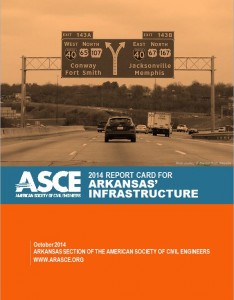 This Thursday, the Arkansas Section of the American Society of Civil Engineers released their inaugural Infrastructure Report Card for the state grading the states’ infrastructure.
Arkansas’ infrastructure received a cumulative GPA of “D+” in the 2014 Report Card for Arkansas’ Infrastructure. The seven infrastructure categories evaluated in the report include:
Roads (D+)
Drinking water (D+)
Transit (D+)
Levees (D)
Dams (D)
Bridges (C+)
Wastewater (C+)
The report noted that Arkansas has the 12th largest highway system in the nation, as well as the second highest traffic fatality rate in the country as of 2010. In addition, the state has 214 wastewater treatment facilities that will need upgrades and improvements in the next 20 years.
The Report Card, the first for Arkansas, was released during the annual ASCE Arkansas Section Conference and included a keynote address by Scott Bennett, director of the Arkansas State Highway and Transportation Department. The report was featured in both the Arkansas Democrat-Gazette and the Times-Record. The effort was led by Aaron Robinson, P.E., based in Jacksonville, Arkansas.
Read the full Arkansas Report Card
This Thursday, the Arkansas Section of the American Society of Civil Engineers released their inaugural Infrastructure Report Card for the state grading the states’ infrastructure.
Arkansas’ infrastructure received a cumulative GPA of “D+” in the 2014 Report Card for Arkansas’ Infrastructure. The seven infrastructure categories evaluated in the report include:
Roads (D+)
Drinking water (D+)
Transit (D+)
Levees (D)
Dams (D)
Bridges (C+)
Wastewater (C+)
The report noted that Arkansas has the 12th largest highway system in the nation, as well as the second highest traffic fatality rate in the country as of 2010. In addition, the state has 214 wastewater treatment facilities that will need upgrades and improvements in the next 20 years.
The Report Card, the first for Arkansas, was released during the annual ASCE Arkansas Section Conference and included a keynote address by Scott Bennett, director of the Arkansas State Highway and Transportation Department. The report was featured in both the Arkansas Democrat-Gazette and the Times-Record. The effort was led by Aaron Robinson, P.E., based in Jacksonville, Arkansas.
Read the full Arkansas Report Card
Tags: Arkansas, bridges, dams, infrastructure, levees, report, report card, roads, transit, wastewater, water
No Comments »
Vermont Infrastructure Shows Improvement in New Report Card
October 17th, 2014 | By: Infrastructure Report Card
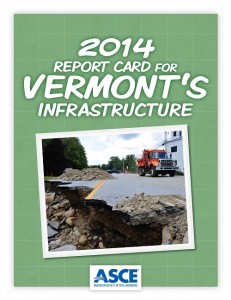 The latest Report Card for Vermont’s Infrastructure showed a slight improvement in their overall GPA to a “C.” The 2014 Report Card for Vermont’s Infrastructure is an update from 2011, when the state received a “C-” cumulative grade. The Report Card assessed bridges (C), dams (C), drinking water (C-), wastewater (D), roads (C-), and solid waste (C+).
After Tropical Storm Irene damaged the state’s infrastructure backbone in 2011, Vermont made significant investments through catch-up and emergency funding. In addition, the state’s most recent transportation funding package provided close to $700 million for transportation infrastructure, the largest transportation infrastructure investment in state history. There have also been programmatic changes. Road fatalities have been cut nearly in half since 2006 due to changes made using the Strategic Highway Safety Plan.
Led by Amanda Hanaway-Corrente, P.E. who chaired the effort and Vermont Section President-Elect Jessica Clark Louisos, P.E., the Report Card was released at a luncheon in Montpelier, which included a keynote from Sue Minter, deputy secretary at the Vermont Agency of Transportation (VTRANS) and David Mears, commissioner of the Department of Environmental Conservation.
“Vermont is poised to grow our economy as we continue to make investments into our infrastructure. The transportation funding that was signed into law in June is one example of how the state continues to focus on innovation and jobs,” said Minter.
Media coverage of the event included the Burlington Free Press and WCAX.
Read the full Vermont Report Card
The latest Report Card for Vermont’s Infrastructure showed a slight improvement in their overall GPA to a “C.” The 2014 Report Card for Vermont’s Infrastructure is an update from 2011, when the state received a “C-” cumulative grade. The Report Card assessed bridges (C), dams (C), drinking water (C-), wastewater (D), roads (C-), and solid waste (C+).
After Tropical Storm Irene damaged the state’s infrastructure backbone in 2011, Vermont made significant investments through catch-up and emergency funding. In addition, the state’s most recent transportation funding package provided close to $700 million for transportation infrastructure, the largest transportation infrastructure investment in state history. There have also been programmatic changes. Road fatalities have been cut nearly in half since 2006 due to changes made using the Strategic Highway Safety Plan.
Led by Amanda Hanaway-Corrente, P.E. who chaired the effort and Vermont Section President-Elect Jessica Clark Louisos, P.E., the Report Card was released at a luncheon in Montpelier, which included a keynote from Sue Minter, deputy secretary at the Vermont Agency of Transportation (VTRANS) and David Mears, commissioner of the Department of Environmental Conservation.
“Vermont is poised to grow our economy as we continue to make investments into our infrastructure. The transportation funding that was signed into law in June is one example of how the state continues to focus on innovation and jobs,” said Minter.
Media coverage of the event included the Burlington Free Press and WCAX.
Read the full Vermont Report Card
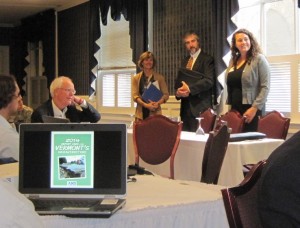

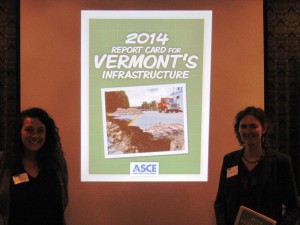
Tags: bridges, dams, grade, infrastructure, report card, roads, transportation, Vermont, wastewater, water
No Comments »
Join the #WaterWorks Thunderclap to Show Your Support for Water Infrastructure Investment
September 3rd, 2014 | By: Becky Moylan
Without clean, safe, and reliable water and wastewater systems, one-fifth of our US economy would grind to a halt. Yet, in the 2013 Report Card for America’s Infrastructure, drinking water and wastewater both received D grades.
On Wednesday, Sept. 10, ASCE will join other water leaders as part of the Value of Water Coalition to share the importance of water with White House and Congressional leaders. If you’re not here in DC, you can still show your support and let Congress know that water should be their priority. Consider joining our Thunderclap on social media – you just need to sign up by next Monday. Thunderclap is a tool that lets a message be heard when we all say it together. When you join the #WaterWorks Thunderclap, you and fellow supporters will share the exact same message at the exact same time, spreading an idea across Facebook, Twitter, and Tumblr that cannot be ignored. The goal is to trend in social media. By joining, you’re allowing Thunderclap to share a single message on your behalf. This is only the case when you click the red button on the campaign page to support with Twitter, Facebook, or Tumblr. After the campaign is complete, Thunderclap won’t post any additional messages. Visit here to help the Value of Water Coalition meet its goal and spread the message through Thunderclap on Facebook, Twitter, and Tumblr. The message in the blue box is what will appear on your own social media pages. Just click the red boxes to share the message. It will automatically go out on September 9, 2014 at 12:00pm EST.Tags: Drinking Water, thunderclap, wastewater, water, Water Resources, Water Works
5 Comments »
This Week in Infrastructure: What is the State of Our Union, Really?
February 2nd, 2014 | By: America's Infrastructure Report Card
The Super Bowl (or the first mass-transit bowl as we like to call it) wasn’t the only required TV viewing this week . The State of the Union drew more than 33 million viewers listening to President Obama’s agenda for the country. Here at ASCE, we were pleased that President Obama laid out goals of “rebuilding our roads, upgrading our ports, unclogging our commutes” and hope that Congress responds by finalizing WRRDA and passing a transportation bill. ENR has an excellent overview of the response from the major players of infrastructure. Looking locally, the Detroit Free Press chimed in with ways that a focus on infrastructure could help Michigan. Prior to his speech, our friend Rep. Blumenauer authored his thoughts Monday on how “If we do not act now to maintain and repair our infrastructure, we will face much higher costs in the future, not just for the country, but for families on a daily basis,” echoing ASCE’s concerns from our Failure to Act studies. It seems infrastructure investment was on everyone’s lips this week. The call for investing in infrastructure is timely for many reasons: First: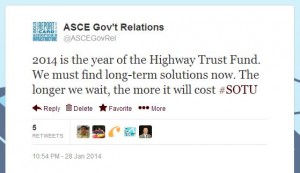 Beyond that, the recent chemical contamination of West Virginia’s water has led to a larger conversation about water quality and the infrastructure that delivers it and disposes of it.
Also this week, there was also some talk of the power grid’s vulnerabilities (which received a D+ in the 2013 Report Card for America’s Infrastructure). Even MetLife Stadium is taking precautions to ensure last year’s blackout is not repeated this Sunday.
Finally, we are going to keep praying for all of our friends in Atlanta. Certainly this was a horrific situation, and hopefully all of us can learn how to avoid such a thing in future.
So, what is the State of Our Union’s Infrastructure, really? I guess you could say we’re working on it.
Beyond that, the recent chemical contamination of West Virginia’s water has led to a larger conversation about water quality and the infrastructure that delivers it and disposes of it.
Also this week, there was also some talk of the power grid’s vulnerabilities (which received a D+ in the 2013 Report Card for America’s Infrastructure). Even MetLife Stadium is taking precautions to ensure last year’s blackout is not repeated this Sunday.
Finally, we are going to keep praying for all of our friends in Atlanta. Certainly this was a horrific situation, and hopefully all of us can learn how to avoid such a thing in future.
So, what is the State of Our Union’s Infrastructure, really? I guess you could say we’re working on it.
Tags: congress, infrastructure, President Obama, Super Bowl, wastewater
No Comments »
Get to Know North Carolina’s Mediocre Infrastructure
June 5th, 2013 | By: America's Infrastructure Report Card
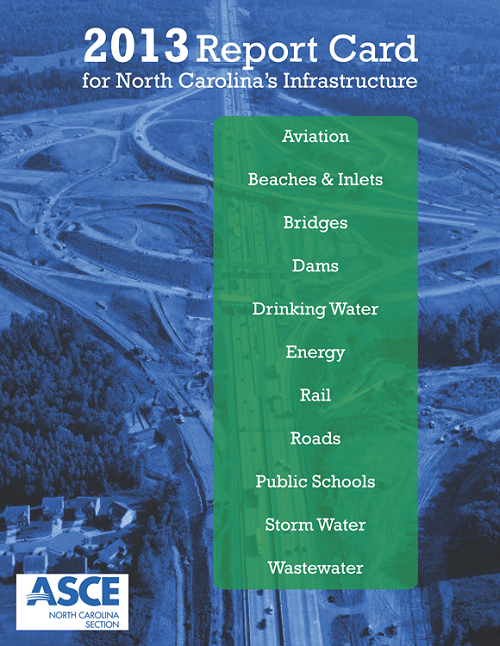 Today, North Carolina’s civil engineers released a new Infrastructure Report Card. After spending a year diving into the details of the state’s infrastructure – from bridges to beaches to dams – they determined that North Carolina’s infrastructure only deserved a mediocre C grade. Like many areas of the country, North Carolina has some work to do to make sure maintenance gets done, aging parts of the system get a modern overhaul, and the infrastructure keeps up with the state’s growth.
The state-wide report examined eleven categories of infrastructure, grading their capacity, resiliency, funding, and reliability. Here’s what they found:
Today, North Carolina’s civil engineers released a new Infrastructure Report Card. After spending a year diving into the details of the state’s infrastructure – from bridges to beaches to dams – they determined that North Carolina’s infrastructure only deserved a mediocre C grade. Like many areas of the country, North Carolina has some work to do to make sure maintenance gets done, aging parts of the system get a modern overhaul, and the infrastructure keeps up with the state’s growth.
The state-wide report examined eleven categories of infrastructure, grading their capacity, resiliency, funding, and reliability. Here’s what they found:
- Aviation earned a D+, in part due to an estimated $763 million needed to bring all airports in the system to a state of good repair.
- Beaches and Inlets were awarded a C-. Many shoals and inlets are functioning at significantly less than authorized depths. Continued erosion of federal and state funding has a significant impact N.C.’s beaches and inlets.
- Bridges earned a C-. North Carolina’s bridges require $281 million more per year in order to make significant strides in raising the grade of North Carolina bridges.
- Dams earned the lowest grade of a D. Ten percent of North Carolina’s high hazard dams are deficient and only 34 percent have Emergency Action Plans. One-third of North Carolina’s dams are over 50 years old.
- Drinking Water earned a C+. North Carolina has over 530 public water systems which serve approximately 7.3 million North Carolinians (75 percent of the state’s population).
- Energy was awarded the highest grade in the report of a B+. North Carolina has a solid foundation of energy and energy infrastructure to meet its current and 20-year planning horizon needs.
- Rail earned a C+, in part due to only 30 percent of the state’s short lines being able to accommodate new, heavier rail cars. It is estimated that freight rail investment needs over the next 25 years will total $545 million.
- Roads earned a C. The scale of the state maintained highway network, current economic circumstances, and the trend of reducing the state transportation agency’s resources and personnel have been challenges to providing and maintaining a sustainable quality of service.
- Schools earned a C. Over 58 percent of North Carolina schools will require renovations in the next five years. Additionally, approximately 10 percent of students are in mobile classrooms. The projected cost to meet facility needs for the next five years is approximately $8.2 billion.
- Stormwater earned a grade of C-. Most of North Carolina’s population lives in communities that have no dedicated source of funding to improve stormwater quality. Statewide sources of funding such as the N.C. Clean Water Management Trust Fund are being reduced and North Carolina’s communities have fewer and fewer options when trying to address their stormwater improvement needs.
- Wastewater earned a C. North Carolina has documented a need of over $4 billion of additional wastewater infrastructure investment needs through the year 2030. These funds are needed to replace aging facilities, comply with mandated Clean Water Act regulations, and keep pace with economic development.
Tags: bridges, continuing education, dams, energy, infrastructure, infrastructure report card, ports, rail transportation, roads, state report cards, transportation, wastewater, water infrastructure
No Comments »
New Report Shows Mississippi’s Infrastructure Needs a Different Approach
July 30th, 2012 | By: America's Infrastructure Report Card
Last week, the Mississippi Section Report Card for the state’s infrastructure was featured in a front-page article in the Jackson Courier-Journal and Acey Roberts, P.E., M.ASCE, chair of the Report Card Committee, was interviewed on the Marshall Ramsey show, heard in Jackson on WFMN-FM. Roberts talked about Report Card which gave grades of D for Dams, D, C- for Drinking Water, C for Roads and Bridges, and C for Wastewater, C. Although the grades for Mississippi are either equal to or slightly higher than the nation’s grades, he said current issues must be addressed. “The current path regarding maintenance and funding for our transportation and water systems in Mississippi must be reversed, said Roberts. “We hope that this report will be the first step toward understanding the issues and finding real solutions to bridge the funding gap. Industry experts from public agencies, private firms and non-profit groups led this Report Card effort. To arrive at grades for each area of infrastructure, civil engineering expert volunteers examined the physical condition, capacity and future need, and studied funding sources and trends that impact maintenance and upgrades. The first report of its kind in Mississippi, ASCE’s Mississippi Section released the Report Card at the Mississippi State Capitol Building. To view the 2012 Mississippi Infrastructure Report Card, visit the ASCE Mississippi Section website. View Clarion-Ledger story. Listen to an archive of the Marshall Ramsey radio show from July 26.Tags: civil engineers, economics, energy, infrastructure, infrastructure report card, state report cards, transportation, wastewater, water infrastructure
No Comments »



 */ ?>
*/ ?>















